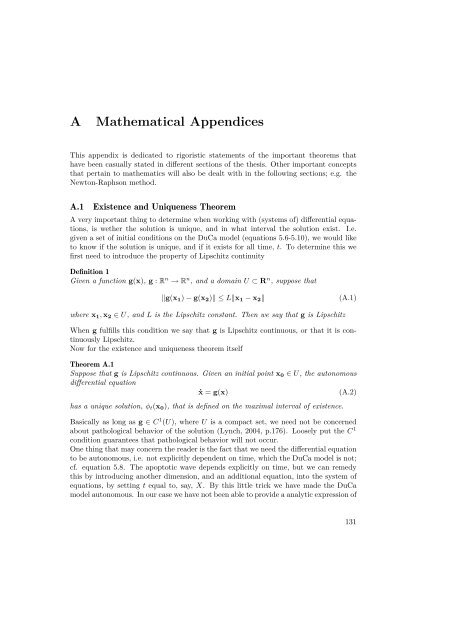nr. 477 - 2011 - Institut for Natur, Systemer og Modeller (NSM)
nr. 477 - 2011 - Institut for Natur, Systemer og Modeller (NSM)
nr. 477 - 2011 - Institut for Natur, Systemer og Modeller (NSM)
You also want an ePaper? Increase the reach of your titles
YUMPU automatically turns print PDFs into web optimized ePapers that Google loves.
A Mathematical Appendices<br />
This appendix is dedicated to rigoristic statements of the important theorems that<br />
have been casually stated in different sections of the thesis. Other important concepts<br />
that pertain to mathematics will also be dealt with in the following sections; e.g. the<br />
Newton-Raphson method.<br />
A.1 Existence and Uniqueness Theorem<br />
A very important thing to determine when working with (systems of) differential equations,<br />
is wether the solution is unique, and in what interval the solution exist. I.e.<br />
given a set of initial conditions on the DuCa model (equations 5.6-5.10), we would like<br />
to know if the solution is unique, and if it exists <strong>for</strong> all time, t. To determine this we<br />
first need to introduce the property of Lipschitz continuity<br />
Definition 1<br />
Given a function g(x), g : R n → R n , and a domain U ⊂ R n , suppose that<br />
g(x1) − g(x2) ≤ Lx1 − x2 (A.1)<br />
where x1, x2 ∈ U, and L is the Lipschitz constant. Then we say that g is Lipschitz<br />
When g fulfills this condition we say that g is Lipschitz continuous, or that it is continuously<br />
Lipschitz.<br />
Now <strong>for</strong> the existence and uniqueness theorem itself<br />
Theorem A.1<br />
Suppose that g is Lipschitz continuous. Given an initial point x0 ∈ U, the autonomous<br />
differential equation<br />
˙x = g(x) (A.2)<br />
has a unique solution, φt(x0), that is defined on the maximal interval of existence.<br />
Basically as long as g ∈ C 1 (U), where U is a compact set, we need not be concerned<br />
about pathol<strong>og</strong>ical behavior of the solution (Lynch, 2004, p.176). Loosely put the C 1<br />
condition guarantees that pathol<strong>og</strong>ical behavior will not occur.<br />
One thing that may concern the reader is the fact that we need the differential equation<br />
to be autonomous, i.e. not explicitly dependent on time, which the DuCa model is not;<br />
cf. equation 5.8. The apoptotic wave depends explicitly on time, but we can remedy<br />
this by introducing another dimension, and an additional equation, into the system of<br />
equations, by setting t equal to, say, X. By this little trick we have made the DuCa<br />
model autonomous. In our case we have not been able to provide a analytic expression of<br />
131
















